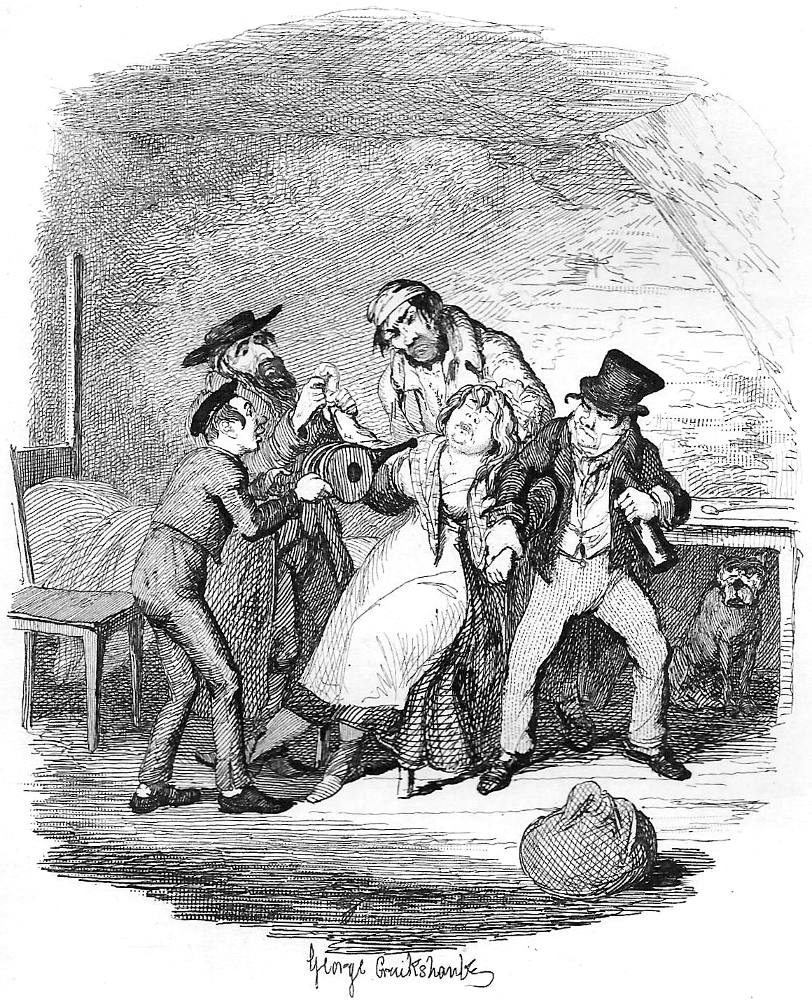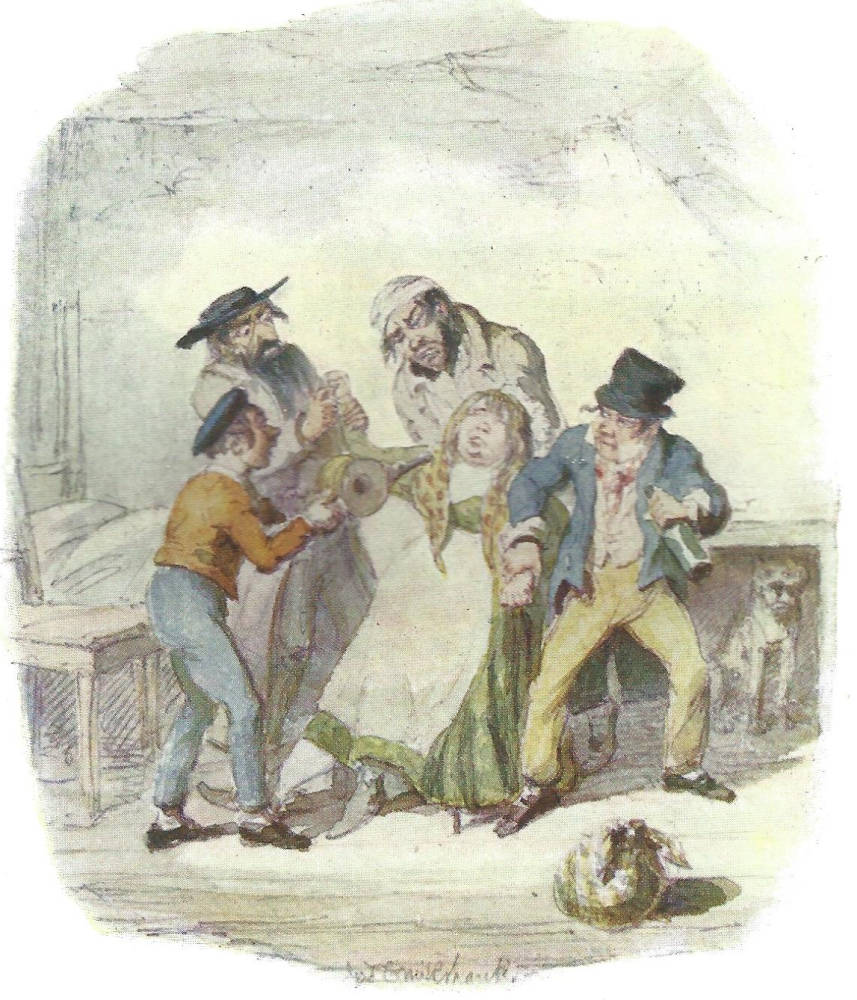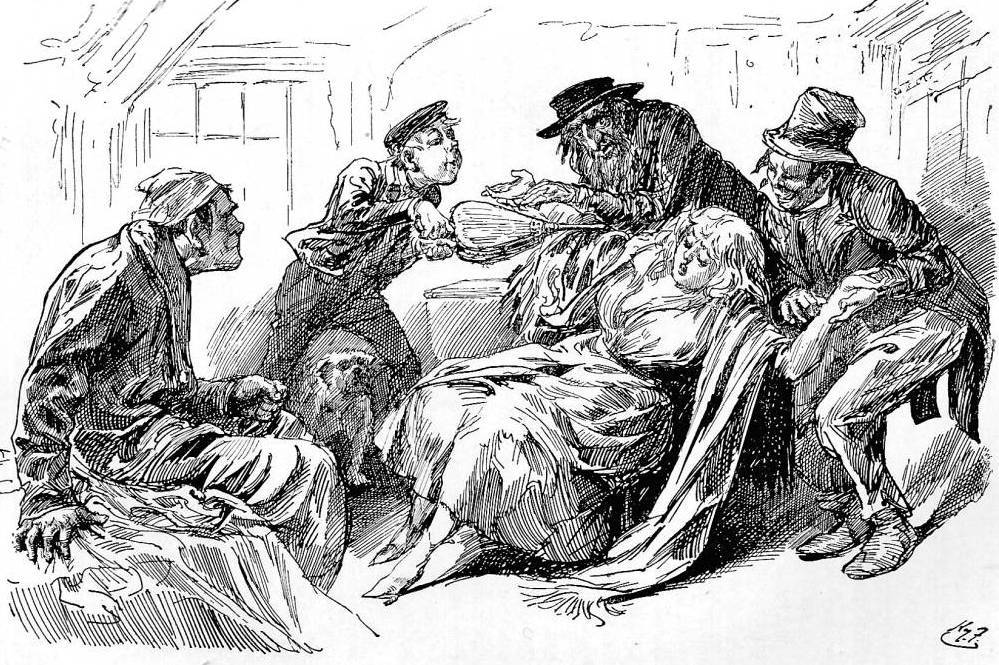

Mr. Fagin and his pupils recovering Nancy — eighteenth steel engraving and later watercolour for Charles Dickens's The Adventures of Oliver Twist; or, The Parish Boy's Progress, first published in volume by Richard Bentley after its August 1838 appearance in Bentley's Miscellany, Part 17, Chapter XXXIX. 4 ½ by 3 ⅝ inches (11.2 cm by 9.2 cm), vignetted, facing page 216 in the 1846 single-volume edition. Cruikshank's own 1866 watercolour, commissioned by F. W. Cosens, is the basis for the 1903 chromolithograph. [Click on the images to enlarge them.]
- Title-page and frontispiece
- George Cruikshank's coloured Illustrations from 1903 Collector's Edition of Oliver Twist
Passage Illustrated: Fagin's Misogynistic Thinking and "Miss Nancy's Hysterics"
"Such a number of nights," said the girl, with a touch of woman's tenderness, which communicated something like sweetness of tone, even to her voice: "such a number of nights as I've been patient with you, nursing and caring for you, as if you had been a child: and this the first that I've seen you like yourself; you wouldn't have served me as you did just now, if you'd thought of that, would you? Come, come; say you wouldn’t."
"Well, then," rejoined Mr. Sikes, "I wouldn't. Why, damme, now, the girls's whining again!"
"It’s nothing," said the girl, throwing herself into a chair. "Don't you seem to mind me. It'll soon be over."
"What'll be over?" demanded Mr. Sikes in a savage voice. "What foolery are you up to, now, again? Get up and bustle about, and don’t come over me with your woman's nonsense."
At any other time, this remonstrance, and the tone in which it was delivered, would have had the desired effect; but the girl being really weak and exhausted, dropped her head over the back of the chair, and fainted, before Mr. Sikes could get out a few of the appropriate oaths with which, on similar occasions, he was accustomed to garnish his threats. Not knowing, very well, what to do, in this uncommon emergency; for Miss Nancy's hysterics were usually of that violent kind which the patient fights and struggles out of, without much assistance; Mr. Sikes tried a little blasphemy: and finding that mode of treatment wholly ineffectual, called for assistance.
"What's the matter here, my dear?" said Fagin, looking in.
"Lend a hand to the girl, can't you?" replied Sikes impatiently. "Don't stand chattering and grinning at me!"
With an exclamation of surprise, Fagin hastened to the girl's assistance, while Mr. John Dawkins (otherwise the Artful Dodger), who had followed his venerable friend into the room, hastily deposited on the floor a bundle with which he was laden; and snatching a bottle from the grasp of Master Charles Bates who came close at his heels, uncorked it in a twinkling with his teeth, and poured a portion of its contents down the patient's throat: previously taking a taste, himself, to prevent mistakes.
"Give her a whiff of fresh air with the bellows, Charley," said Mr. Dawkins; "and you slap her hands, Fagin, while Bill undoes the petticuts."
These united restoratives, administered with great energy: especially that department consigned to Master Bates, who appeared to consider his share in the proceedings, a piece of unexampled pleasantry: were not long in producing the desired effect. The girl gradually recovered her senses; and, staggering to a chair by the bedside, hid her face upon the pillow: leaving Mr. Sikes to confront the new comers, in some astonishment at their unlooked-for appearance. [Chapter XXXIX, "Introduces some respectable Characters with whom the Reader is already acquainted, and shows how Monks and the Jew laid their worthy Heads together," pp. 215-216 in the 1846 edition]
Commentary
Having been at Broadstairs on holiday during the summer months, Dickens did not write his usual instalment for the September number of Bentley's Miscellany, offering his readers instead the "Full Report of the Second Meeting of the Mudfog Association for the Advancement of Everything," a continuation of his October 1837 spoof of British scientific societies. Thus, readers of the magazine serial had to wait a month before they were able to move from chapters 38 and 39 in August to chapters 40 and 41 in October (instalment 18).
The novel's seventeenth monthly part, containing chapters 38 and 39, did not have the usual single illustration for the instalment, but two (August 1838). This departure suggests that the periodical's manager, Richard Bentley, had decided to commit Cruikshank's talents entirely to the novel as the house artist previously had contributed just one plate to the novel and another elsewhere in the monthly issue of Bentley's Miscellany to a different subject. Here, Cruikshank exhibits his penchant for character comedy, but at the expense of Dickens's attempts to ennoble Nancy, or at least have readers take her more seriously.

Sol Eytinge, Junior's Bill Sikes and Nancy (1867) merely emphasizes their degradation after the robbery.
Cruikshank's somewhat sexist depiction of the distressed Nancy and her frowsy partner, the down-and-out housebreaker with the soiled nightcap, marks a turning point in the plot. Nancy, having been mistreated by Sikes after nursing him through a fever, has overheard the plotting of Fagin and Monks, and has approached Rose Maylie with the story of Monks's behind-the-scenes manipulations of Oliver's fortunes. In this second illustration from Part 17, Fagin and his chief juvenile collaborators, Charley Bates and Jack Dawkins, assist the ailing Bill Sikes in recovering Nancy from an hysterical fit.
Unlike both F. W. Pailthorpe and James Mahoney, Cruikshank and Furniss focus on the physical comedy of Nancy's "hysterics" and the gang's attempting to cure her of them. The other illustrators have dealt instead with the deplorable physical and mental state into which Sikes and his common-law wife have fallen since the botched robbery in Chertsey. Only seven serial instalments and illustrations were yet to appear in the magazine, but already Bentley must have been organizing the publication of the novel in three volumes (9 November 1838). And already Dickens and Cruikshank were winding up the story.

F. W. Pailthorpe's portrait of the gentlemanly housebreaker playing cribbage in the gang's hideout, Mr. Crackit's "Goodnatur'" (1886), focuses on a more genial scene in Ch. 39.
Undoubtedly intended as a piece of low character comedy, this second August 1838 illustration neither realizes a significant moment in the plot such as the meeting at London Bridge, nor adds appreciably to the reader's understanding of any of the characters involved. We may regard it as directing our attention towards Nancy's ability to adopt a pose in order to distract the gang from her intention to sneak away. Shortly, he will unmask Monks and disclose his machinations. A more pertinent scene would have been Nancy's overhearing Monks and Fagin subsequently in this instalment. Furthermore, Cruikshank's fat, slatternly Nancy does not correspond with Dickens's intention to develop Nancy as the attractive, young harlot with the heart of gold whose tender concern for the persecuted child undermines Monks's carefully laid plot. The illustration does serve to heighten suspense since Nancy's so easily falling into hysterics makes one wonder whether she us equal to the task of holding her emotions in check around Sikes, and slipping away undetected for the fateful meeting with Mr. Brownlow and Rose Maylie beneath London Bridge.
Cruikshank might have detailed the contents of Fagin's "care package" intended to mollify Bill for Fagin's apparent neglect of him over the past month, but, instead of the green tea, two-pound loaves, butter, massive rabbit pie, and Gloucester cheese, all that Cruikshank has included is the sack (in fact, an old tablecloth) in the foreground and the wine-bottle in the Dodger's hand. The only significant piece of detailing is the bellows. In the illustration as opposed to the text, Sikes's dog plays no active role in the scene, being consigned to the area under the table (right). Cruikshank usefully, however, in this Newgate farce foregrounds the semi-conscious Nancy, and makes her the subject of the scrutiny of Fagin and Sikes, although the composition of the tableau is hardly likely to "rewive the drayma," despite the waggish Master Bates's assertion.
Illustrations from Other Editions (1867 through 1910)


Left: James Mahoney's Then, stooping softly over the bed, she kissed the robber's lips realizes Nancy's divided loyalties and the gentler side of her character for the Household Edition. Right: Harry Furniss's Charles Dickens Library Edition illustration (1910) theatrically depicts the same farcical scene selected by Cruikshank, Nancy in Hysterics. [Click on the images to enlarge them.]
Related Material
- Oliver Twist as a Triple-Decker
- Oliver untainted by evil
- Like Martin Chuzzlewit, it agitates for social reform
- Oliver Twist Illustrated, 1837-1910
Scanned images and text by Simon Cooke, color correction, sizing, caption, and commentary by Philip V. Allingham. [You may use these images without prior permission for any scholarly or educational purpose as long as you (1) credit the photographer and (2) link your document to this URL in a web document or cite the Victorian Web in a print one.]
Bibliography
Bentley, Nicolas, Michael Slater, and Nina Burgis. The Dickens Index. New York and Oxford: Oxford U. P., 1990.
Cohen, Jane Rabb. "George Cruikshank." Charles Dickens and His Original Illustrators. Columbus: Ohio State U. P., 1980. Pp. 15-38.
Darley, Felix Octavius Carr. Character Sketches from Dickens. Philadelphia: Porter and Coates, 1888.
Davis, Paul. Charles Dickens A to Z: The Essential Reference to His Life and Work. New York: Facts On File, 1998.
Dickens, Charles. The Adventures of Oliver Twist; or, The Parish Boy's Progress. Illustrated by George Cruikshank. London: Bradbury and Evans; Chapman and Hall, 1846.
_______. Oliver Twist. Works of Charles Dickens. Household Edition. 55 vols. Illustrated by F. O. C. Darley and John Gilbert. New York: Sheldon and Co., 1865.
_______. Oliver Twist. Works of Charles Dickens. Diamond Edition. 14 vols. Illustrated by Sol Eytinge, Jr. Boston: Ticknor and Fields, 1867.
_______. Oliver Twist. Works of Charles Dickens. Household Edition. 22 vols. Illustrated by James Mahoney. London: Chapman and Hall, 1871. Vol. I.
_______. The Adventures of Oliver Twist. Works of Charles Dickens. Charles Dickens Library Edition. 18 vols. Illustrated by Harry Furniss. London: Educational Book Company, 1910. Vol. 3.
Forster, John. "Oliver Twist 1838." The Life of Charles Dickens. Ed. B. W. Matz. The Memorial Edition. 2 vols. Philadelphia: J. B. Lippincott, 1911. Vol. 1, book 2, chapter 3. Pp. 91-99.
Grego, Joseph (intro) and George Cruikshank."Mr. Fagin and his pupils recovering Nancy." Cruikshank's Water Colours. [27 Oliver Twist illustrations, including the wrapper and the 13-vignette title-page produced for F. W. Cosens; 20 plates for William Harrison Ainsworth's The Miser's Daughter: A Tale of the Year 1774; 20 plates plus the proofcover the work for W. H. Maxwell's History of the Irish Rebellion in 1798 and Emmett's Insurrection in 1803]. London: A. & C. Black, 1903. OT = pp. 1-106]. Page 70.
Kitton, Frederic G. "George Cruikshank." Dickens and His Illustrators: Cruikshank, Seymour, Buss, "Phiz," Cattermole, Leech, Doyle, Stanfield, Maclise, Tenniel, Frank Stone, Topham, Marcus Stone, and Luke Fildes. 1899. Rpt. Honolulu: U. Press of the Pacific, 2004. Pp. 1-28.
Pailthorpe, Frederic W. (Illustrator). Charles Dickens's Oliver Twist. London: Robson & Kerslake, 1886. Set No. 118 (coloured) of 200 sets of proof impressions.
Patten, Robert L. George Cruikshank's Life, Times, and Art, Volume Two: 1836-1878. New Brunswick, New Jersey: Rutgers University Press, 1996.
Patten, Robert L. George Cruikshank: A Revaluation. Princeton: Princeton U. P., 1992.
Created 9 September 2014 Last modified 15 January 2022